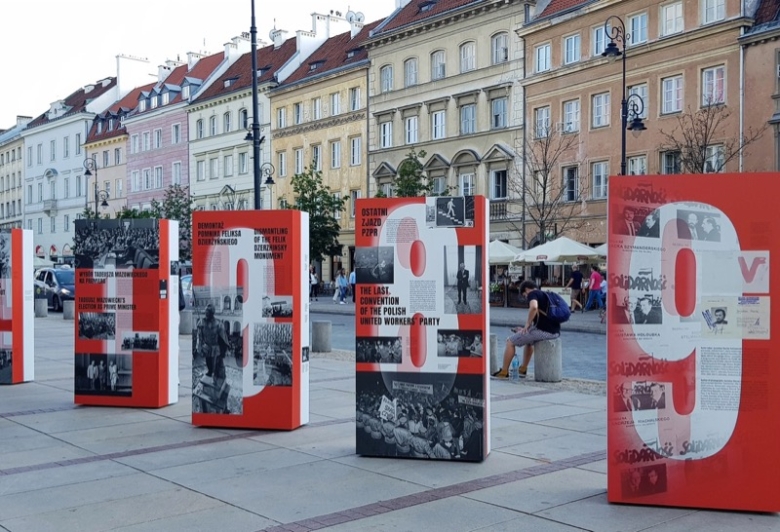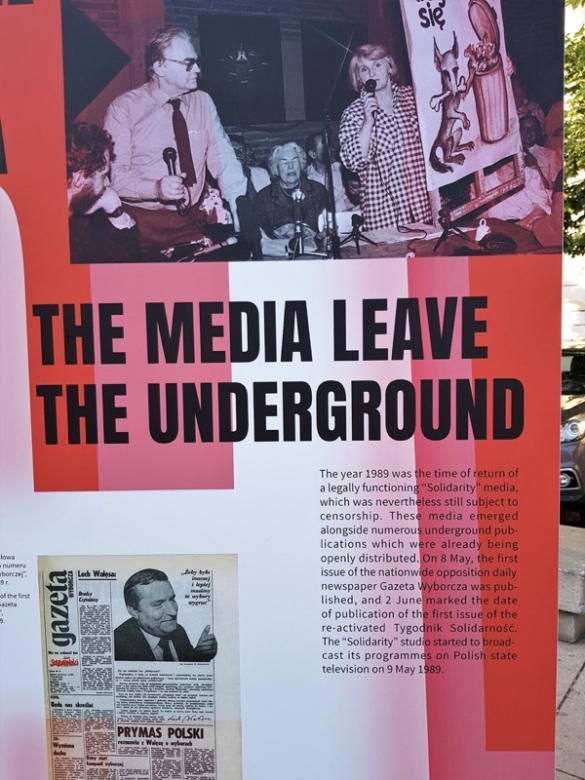Periodistas de Europa Central y Oriental debaten cuestiones críticas sobre la religión en las noticias
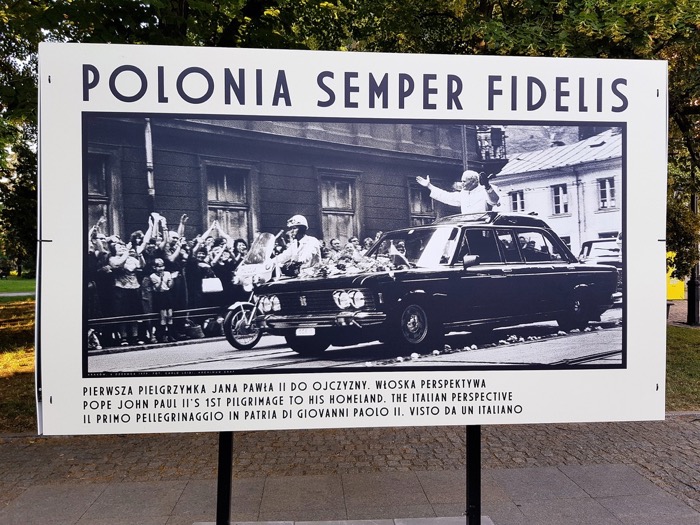
WARSAW, Poland, June 13-14, 2019—Journalists from Central and Eastern Europe gathered in Warsaw for a conference exploring coverage of faith issues in public life, politics and history in the region, organized by the International Association of Religion Journalists (IARJ).
The conference, called Periodismo y religión en Europa Central y Oriental, was attended by 30 participants. The timely issues they discussed included:
- Journalistic treatment of religious and cultural minorities;
- Coverage of migration, religion and politics;
- Reporting on the Vatican and the Roman Catholic Church, and on Orthodox Churches;
- Counteracting hate speech and fake news.
The conference included IARJ representatives from Western Europe, North America and the Maghreb, along with a scholars from the region. It was hosted by the Faculty of Journalism, Information and Book Studies of the University of Warsaw (UW) https://www.wdib.uw.edu.pl/en/home.
What follows is a sampling of images and comments from major sessions within the conference.

Religious And Cultural Diversity:
Cover Minorities While Reporting On Majorities
Among the comments at this session:
Philosopher Stanislaw Krajewski, co-chief of the Polish Council of Christians and Jews, argued that there are many kinds of minorities; probably each of us belongs to one. It’s impossible to take all into account.
According to him, even if we identify minorities to be taken into account, it is natural to have the majority in the back of one’s head, and to accept the dominant, usually majority-serving, norms.
Krajewski, who is co-author of the post-war section of the core exhibition in the Museum of History of Polish Jews POLIN https://www.polin.pl/en, also reflected on the political impact of the coverage of minorities, and what taboos, if any, are lifted.
Zuzana Kepplová of Slovakia, a journalist with newspaper SME https://www.sme.sk/, explained that in her country religion is often understood as tied to ethnicity, to national heritage which should not be shared with Romas.
Kepplová illustrated her point with a story that the newspaper ran about empty churches in Gemer, a region with poor infrastructure and lacking services. We decided to tell the story of priests who get melancholic as churches get renovated and turned into potential tourist sites while they are losing believers. They only meet Romas
dijo.for baptism and funeral
,
Reporting on Refugees, Islam and European and National Politics
Among the comments at this session:
Karol Wilczyński of Poland, a journalist with Catholic website DEON https://www.deon.pl/ and co-creator with his wife Anna of https://islamistablog.pl/, posed the question if, regarding the so-called “migration crisis” started in Europe in 2015, is it enough to be the voice for the voiceless. He noted than since 2015 anti-Islamic and anti-refugee sentiments are on the rise in Poland,
whereas Muslims and refugees themselves are barely present in Polish society. Wilczyński argued that being
.the voice for the voiceless
—meaning: Muslims and refugees—may still not be enough to report in an unbiased way and break the polarizing dichotomy between para
y contra
Viktória Serdült of Hungary, a journalist with HVG https://hvg.hu/, summarized the situation in her country this way: Reporting on refugees and Islam in Hungary is reporting against the currents. Such currents can be two-fold: first, it’s the lack of resources; secondly it’s Government control of the media. And as in most cases, the two are interconnected.
According to Serdült, because of the lack of funding, the number of first-hand accounts of refugee issues, Islam and international politics, have decreased,
and news coming from Government-controlled media outlets offer news reports influenced by anti-migration, anti-Islam and anti-European Union rhetoric of the governing party.
Joanna Szylko-Kwas, a scholar in the Faculty of Journalism at the University of Warsaw, presented her analysis of coverage of refugees by Polish daily press, with special attention to the function of photography. She recalled how in Poland this issue is all the more common since it constitutes an element of the ongoing dispute between the governing party and the opposition, and more importantly, between the Polish government and the European Union.
Szylko-Kwas concluded that the level of emotions related to the presented topic periodically increases, especially when there are some new related occurrences, only to drop later, yet it never dies out completely.
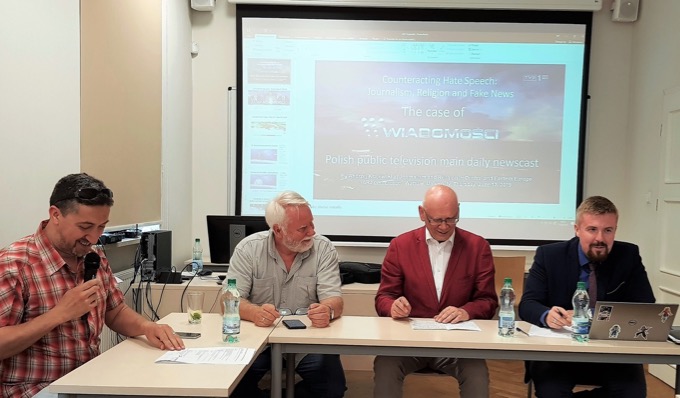
Counteracting Hate Speech:
Journalism, Religion and Fake News
Among the comments at this session:
Adam Szostkiewicz, a journalist with Polish newspaper Polityka https://www.polityka.pl/TygodnikPolityka, raised the issue of hate speech in the field of religion by discussing a number of examples dealing with Jews, Islam and the Roman Catholic Church in Poland. He argued that there is no quick solution because these are very emotional and divisive issues in public perception.
Szostkiewicz also noted that a concerted effort by all sorts of institutions which are supposed to deal with these issues, including public and church authorities, as well as public media, may be desperately needed to tackle the problem
.
Andrzej Krajewski of Poland, a TV journalist who focuses on free speech, presented an analysis on Wiadomości, a daily newscast in Polish television that airs during prime time at 7:30 pm. He stated that 75% of Wiadomości titles were of evaluation character instead of informative one.
Krajewski explained that the activities of the authorities were described with words such as: reform, strong, hero, help, sovereign,
whereas the activities of the opposition were described by words such as: scandalous, shocking, provocative, arrogance, coup d’état, embarrassing, escalation, savagery
.
Tomasz Gackowski, a scholar in the Laboratory of Media Studies https://www.lbm.uw.edu.pl/en/ at the University of Warsaw, stated that hate speech as a fatal phenomenon of present days seems to affect almost everybody.
He noted that the web seems to be not only a space of freedom and interaction, but also a great environment for hate speech,
and he elaborated on the dangers posed in the internet by fake news and deep fakes. Gackowski argued that in the present times of post-truth and post-politics defined by Baumann, for many people the truth isn’t a value which we should take care of, but the thing to challenge or even to mislead.
Reporting on the Vatican and the Roman Catholic Church
Among the comments at this session:
Paweł Bravo of Poland, a journalist with Catholic weekly Tygodnik Powszechny https://www.tygodnikpowszechny.pl/, said that many things have changed in Poland over the last 30 years, but not the attitude of the Catholic Church towards journalists.
According to Bravo, the behaviour of Polish bishops towards journalists is frozen in the 1980s, they don’t even organize real press conferences, and they treat us as enemies.
He claimed that he and his colleagues have to rely heavily on personal contacts for interesting stories, and to call sources in the Vatican who were active there during the pontificate of Polish Pope John Paul II.
Saulena Žiugždaitė de Lituaniaperiodista del diario católico en línea Bernardinai http://www.bernardinai.lt/argumentó que la era del Papa Francisco abrió una edad de oro para los medios de comunicación católicos, animando a los periodistas a hacer bien su trabajo y expresando una firme postura a favor de la transparencia en la Iglesia, especialmente en cuestiones de abusos sexuales, abuso de poder y transacciones financieras.
Explicó cómo Bernardinaifundada por los franciscanos en 2004, lucha periódicamente por la financiación. La Iglesia católica local espera que formemos parte de su aparato de relaciones públicas en la guerra ideológica; tanto la jerarquía como los lectores laicos tardaron en comprender la naturaleza del periodismo,
concluyó.
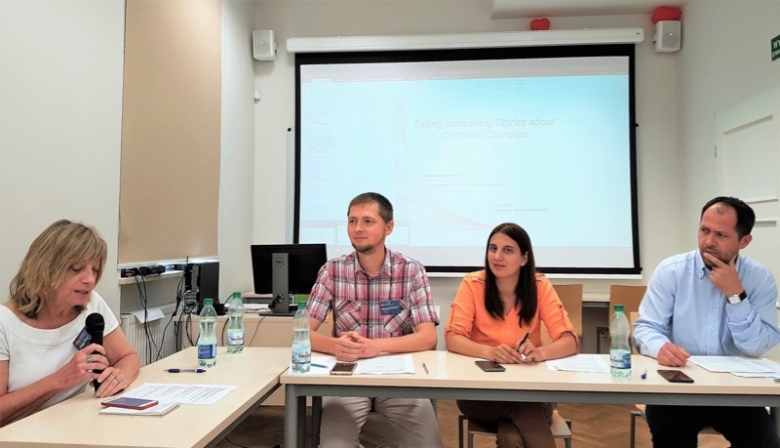
Contar historias convincentes sobre las iglesias ortodoxas
Among the comments at this session:
Jelena Jorgačević Kisić de Serbia, a journalist with Vreme https://www.vreme.com/La directora general de la Fundación para la Ortodoxia y la Religión de la Iglesia Ortodoxa, la eurodiputada socialdemócrata Hodgson, habló de los obstáculos y retos que plantea escribir sobre la Iglesia Ortodoxa. Señaló que los reportajes sobre la Ortodoxia a menudo hacen hincapié en sus aspectos místicos y exóticos y reproducen estereotipos. Argumentó que aunque esta imagen mística puede resultar atractiva para el público y, por tanto, para que el periodista
Jorgačević Kisić también abordó la postura de la Iglesia ortodoxa serbia ante los medios de comunicación, y se explayó sobre utilice
no proporciona la información necesaria, no profundiza en la comprensión ni aporta un contexto fiable.su cercanía, debida no sólo a
regular
tensión entre los medios de comunicación y las iglesias, sino también a los antecedentes históricos.
Ciprian Dumea, de Rumanía, periodista de la cadena pública TVR http://www.tvr.ro/, habló del reciente viaje del Papa Francisco a su país natal, que cubrió siguiéndole de cerca durante tres días, reuniéndose con las tres principales confesiones: Ortodoxa, Católica Romana y Católica Griega. Antes de eso, me propuse exponer historias en las que me sentí discriminado confesionalmente, tanto en la sociedad como especialmente en el lugar de trabajo, donde soy el único católico en una editorial de programas religiosos con diez personas,
dijo. Según Dumea, los días pasados por el Papa Francisco en Rumanía fueron para toda nuestra sociedad una especie de lección de convivencia.
Maksym Balaklytskyi, de Ucrania, periodista de Nadiia TV, explicó que la Iglesia Ortodoxa en Ucrania solía percibirse como un sustituto de la estatalidad desaparecida, un símbolo de
Dijo que, a partir de un estudio de 2018, 71,7% ucranianos se declararon creyentes, y 67,3% se identificaron como ortodoxos. Ucrania
.En 2018, Tomosel documento del Patriarca de Constantinopla Bartolomé en el que se respalda el autogobierno de la Iglesia Ortodoxa Ucraniana, fue nombrado principal neologismo del año en los medios de comunicación ucranianos,
afirmó Balaklytskyi. También explicó cómo Tomos se convirtió en un problema para los políticos en el marco del actual conflicto con Rusia.
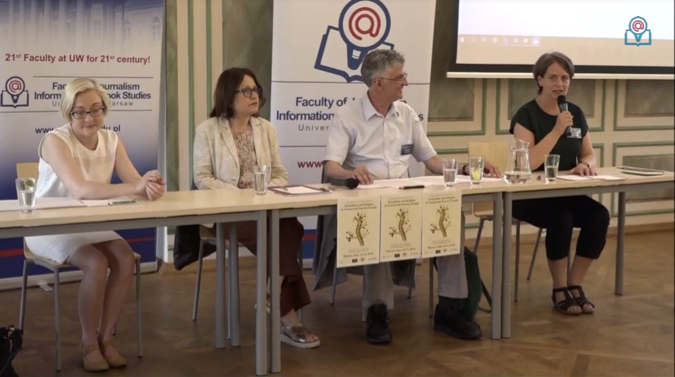
Sesión pública:
De la solidaridad hacia adelante
Dentro de la conferencia de la IARJ, también hubo una sesión abierta al público, patrocinada por la Asociación de Archivos de Datos Religiosos (ARDA), http://www.thearda.com/bajo el título De Solidaridad en adelante: La enmarañada red de religión, historia y política en Europa del Este. Esta sesión se retransmitió en línea y puede verse aquí: https://theiarj.org/blog/2019/06/13/view-arda-and-iarj-public-forum-in-warsaw-on-religion-in-eastern-europe/
Among the comments at this session:
El polaco Christopher Garbowski, of Maria Curie-Skłodowska University https://www.umcs.pl/en/, focused on some social currents affecting religion in Poland. Religion was an essential force in augmenting the spirit of resistance to the totalitarian communist regime for Poles—not the least in the Solidarity movement of the 1980s,
he said. Garbowski added that it is less known that the communists were against the family almost to the same degree that they opposed religion,
while the Catholic Church supported it. Among other issues about present Poland, Garbowski noted how a predominantly Catholic society has such a low birth rate.
He also argued that, if religious practice has decreased among younger Poles, under the new circumstances religion has to a larger extent become a matter of personal choice rather than received tradition, and a deeper religiosity of a significant percentage of these Poles is also evident.
Bulgarian scholar Ina Merdjanova, senior researcher and adjunct assistant professor in religious studies at the Irish School of Ecumenics, Trinity College Dublin https://www.tcd.ie/ise/, explored religion, conflict and peacebuilding in the Balkans. She framed the region as a place where four major religious traditions—Orthodox Christianity, Roman Catholicism, Judaism and Islam—have coexisted and interacted for centuries.
Merdjanova recalled oppression of religions under communist secularist regimes, and how afterwards there was a return
of religion in the public sphere. While the wars in ex-Yugoslavia were by no means religious wars, religion was implicitly involved in deepening social divisions and exacerbating tensions,
she argued. Merdjanova noted that since then, interreligious dialogue has become a central tool in the continuous international efforts to promote peaceful coexistence.
Malgorzata Glowacka-Grajper, a sociologist and social anthropologist, assistant professor at the Institute of Sociology, University of Warsaw http://www.is.uw.edu.pl/pl/english/, presented the memory landscape and memory activism of local communities where state institutions have created national memorials concerning Polish history of the 20th century. The analysis of field research found that local, traditional ways of commemoration embedded in the religious language and symbols are often not recognized as important by people outside of these communities and even ignored by them.
Glowacka-Grajper argued that, depending on the situation, local memory activism based on the religious way of thinking about victimhood collide or connects with the historical politics of the Polish state based on the changing images of the national martyrs and heroes.
IARJ Representatives
The IARJ representatives in this meeting, who acted as moderators of the various panels and as facilitators of the final workshop, were:
- IARJ international chair Douglas Todd of Canada, religion writer with the Vancouver Sun https://vancouversun.com/;
- Peggy Fletcher Stack of the United States, religion writer for the Tribuna de Salt Lake https://www.sltrib.com/;
- Astrid Dalehaug Norheim of Norway, editor at Dagen https://www.dagen.no/;
- Elisa Di Benedetto of Italy, freelance journalist;
- Larbi Megari of Algeria, TV journalist;
- and the author of this article, María-Paz López of Spain, foreign correspondent and religion columnist with La Vanguardia https://www.lavanguardia.com/, who served as chairwoman of the conference.
Janusz Adamowski, dean of the Faculty of Journalism, opened the works on the first day.
Remembering Sasa Milosevic
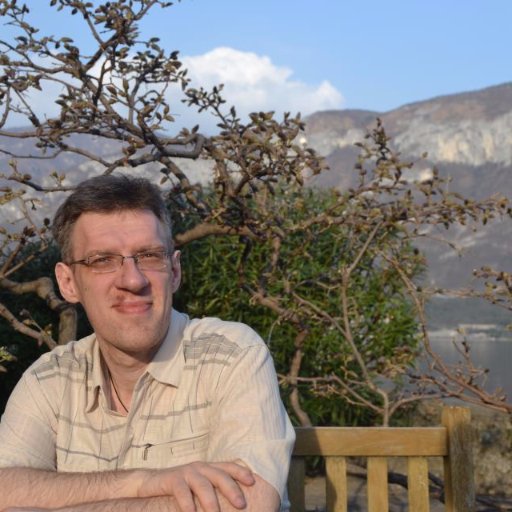
Within the conference, there was a touching moment of remembrance for Sasa Milosevic, a Serbian journalist and devoted founding member of the IARJ who died in December 2018.
Peggy Fletcher Stack, who worked with Sasa in a crossborder story years ago, evoked his memory.
She also shared some moving words sent American journalist David Briggs, who knew Sasa well and had extensive conversations with him.
Conference Sponsors
The conference Periodismo y religión en Europa Central y Oriental was financially possible thanks to the generous support of three American donors: the Kem C. Gardner Policy Institute https://gardner.utah.edu/, the Sam & Diane Stewart Family Foundation http://www.stewartfamilyfoundation.org/#the-stewart-family-foundation , and the Clark and Christine Ivory Family Foundation.
The objectives of this Warsaw meeting related to the general goals of the European Academy of Religion (EuARe) https://www.europeanacademyofreligion.org/, an European platform for research, communication and exchange on religious topics in universities and society, of which the IARJ is an active member.
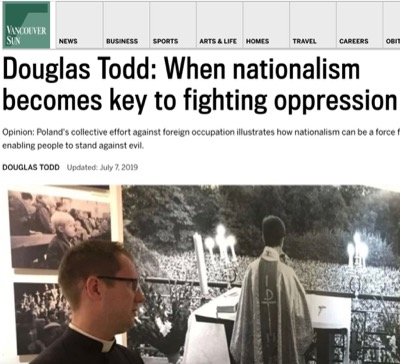
Care for More?
CHECK OUT THE CONFERENCE ON TWITTER—More info about the conference can be traced in Twitter using the hashtag #IARJWarsaw
DOUGLAS TODD published a column in the Vancouver Post about Poland’s legacy of the Solidarity movement.
And More from the Streets of Warsaw…
This year, 2019, is also the 30th anniversary of the collapse of Communism across much of Eastern Europe. While our participants were in Warsaw, historic details of that era were on display in central Stare Miasto-Old Town along central Krakowskie Przedmieście.
